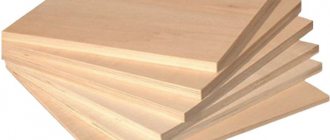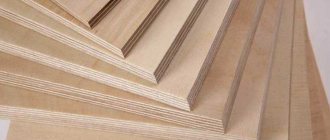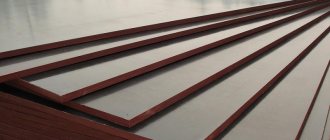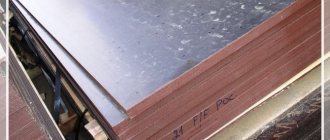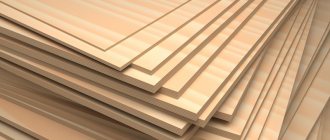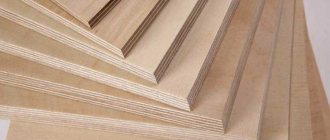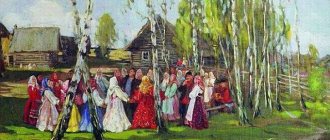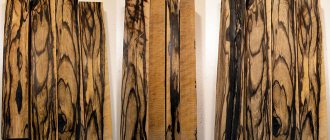Kinds
Depending on the glue used
- FSF (phenol-formaldehyde glue) - the highest level of moisture resistance. Due to harmful substances in the resin, it is not recommended for residential premises and furniture production;
- FKM (melamine glue) – average level of moisture resistance. It has a lower content of harmful substances, but also lower resistance to humidity, so it can be used wherever there are no increased requirements for moisture resistance and toxicity levels;
- FC (urea glue) – low level of moisture resistance. It does not contain harmful substances, therefore it can only be used in the interior decoration of residential premises, as well as kindergartens, rooms, furniture;
- FBA (albumin-casein glue) is a non-waterproof plywood. It is environmentally friendly and can be used anywhere where increased resistance to moisture is not needed.
Bakelized plywood
Impregnation with bakelite varnish
Separately, it is necessary to highlight bakelite plywood (FB). It is impregnated with bakelite glue and has the highest level of moisture resistance and response to the conditions of the surrounding aggressive environment. Can be used: at high/low temperatures; from tropical to northern climates, with constant exposure to sea water, microorganisms, etc.
Because This building material is quite expensive, for the convenience of buyers, bakelite plywood is divided into several more subtypes: according to the composition of the resin, as well as according to the gluing method, so that everyone can choose the right brand and not overpay in vain:
- FBS (impregnation with alcohol-soluble glue), the main advantage is moisture resistance:
- FBS brand: all layers of veneer are completely impregnated, the highest quality material;
- Brand FBS-1: the layers are not impregnated, but only coated, the quality is slightly lower;
- Brand FBS-1A: only longitudinal layers are coated.
Waterproof material
- FBV (impregnation with water-soluble glue), the main advantage is strength:
- FBV brand: only the outer layers are impregnated, and the inner layers are coated;
- Brand FBV-1: veneer is only coated.
On the surface
Plywood with a treated surface layer
Types of plywood for surface layer treatment:
- Laminated. To enhance all the qualities of wood, the outer layers are covered with a special film to additionally protect the surface;
- Polished on both sides (Ш2);
- Polished on one side (Ш1);
- Unsanded (NS).
The surface of the plywood is sanded to remove defects and make it more aesthetically attractive.
Basically, polished and laminated are used for finishing or decorative finishing, as well as for creating the front parts of furniture.
Water resistance and grades of plywood
The resistance of the material to moisture is largely determined by the composition of the glue. There are two brands of plywood FSF and FK, differing in the level of resistance of the adhesive layer to moisture and purpose. Both are distinguished by their water resistance, while the first is increased, and can be used for finishing external structures and premises.
FC plywood is used exclusively for interior work and has the following characteristics:
- Specific humidity for sheets with a thickness of 3 to 30 mm is in the range from 5 to 10%.
- Mechanical strength limit:
- when bending along a line parallel to the fibers of the outer layers - 25 MPa;
- when stretched along the fibers – 30 MPa.
- The elastic modulus of the panel is 7000 MPa.
- Impact viscosity – 34 KJ/m2.
- Thermal conductivity depending on density from 0.09 to 0.24 W (mK).
- Water vapor resistance coefficient from 50 to 110.
When testing FK grade plywood for water resistance, it is soaked in cold water for 24 hours. After this, the fracture strength of the sheet is determined by the adhesive joint and veneer layers. Thus, for high-quality material, under a load ranging from 0.6 to 1.0 MPa, chipping in wood is 40% or more.
This plywood, the characteristics and properties of which allow it to be used at a humidity of more than 80%, is highly resistant to adverse environmental factors. It is able to retain its shape even with prolonged exposure to precipitation and is not subject to warping. At the same time, the multilayer plate has a low specific gravity and is easy to machine.
Classification by variety
How to find out the fvnera variety
- Grade E (elite) - defects are not allowed, except for minor random changes in the structure of the wood;
- Grade 1 - the maximum length of warping or cracks should not exceed 20 mm;
- Grade 2 - cracks up to 200 mm, wood inserts, glue leakage up to 2% of the total sheet area are allowed;
- Grade 3 - up to 10 wormholes are allowed. per m2, with a diameter of each no more than 6 mm; the total number of listed defects cannot be more than 9;
- Grade 4 - extremely low quality. May have the following defects: partially fused and fallen knots - without limitation; wormholes with a diameter of up to 40 mm without limitation; defects in sheet edges up to 5 mm deep.
Application in construction
Thus, the grade of plywood depends on the presence of defects and their number on the surface of the wood veneer. At the same time, all types of plywood are used:
- Grade E and Grade 1: decorative finishing, finishing interior and exterior;
- Grade 2 and Grade 3: rough finishing or finishing, with additional application of varnishes and paints to mask defects;
- Grade 4: rare - internal rough finishing, mainly used for the manufacture of containers and packaging.
At the same time, the marking on the label may be, for example, this: 3/4 or 4/4, this means that on the outside of the sheet the quality is of one grade, and on the inside - another. Such products are very popular on the Russian market, because... For the price, it is much more profitable.
Features of making furniture from plywood
Knowing about the flexibility of plywood in work, many home craftsmen have probably thought about making their own furniture. And in reality there is nothing particularly complicated here - you just need to follow simple recommendations in your work.
The instructions for working with plywood provide several tips:
- This rule applies to working with sheets of different thicknesses:
- The thickness of which is no more than 1.5 mm. In this case, the material should be cut exclusively with a knife.
Cutting a sheet using a stationery knife.
- If the thickness is more than one and a half millimeters, but less than six, then you should use a jigsaw.
- If the sheet is more than 6 mm thick, it will have to be cut with a circular saw.
- Never cut plywood boards across the grain, as this will cause the material to crack. To prevent this, loosening cuts should be made. They are made using a knife, applied parallel to the sawing line.
- Before joining sheets with screws or nails, it is necessary to pre-drill holes, otherwise cracks will form in the material.
Advice! If you are connecting building materials made of soft wood with screws, then you should place small washers under their heads.
- To bend the panel, you must first moisten it with water and then fix it. The sheet should be kept in this position for about 12 hours.
Bend the panel using the tire to give it shape.
- There are simple instructions for gluing plywood:
- It is necessary to start by sanding the area of gluing with sandpaper.
- Apply the adhesive composition in an even thin layer.
- We compress the material until it dries completely.
Advice! If the glued sheets will be used in conditions of high humidity, then waterproof glue should be used. When gluing, it is necessary to maintain strict parallelism of the fibers.
- In case of peeling of plywood, it is necessary to use paper pads to glue its layers.
Division by type of wood
Based on the type of wood veneer, there are three types: birch, coniferous and combined. At the same time, they look only at the composition of the outer layers.
Berezovaya
From deciduous species
Birch refers to the deciduous type of construction plywood. Birch bark veneer is a very durable and dense material that has a uniform structure.
On topic - what advantages does birch plywood have over coniferous plywood?
The density of such plywood is approximately 650 kg/m3, i.e. a sheet of such material is 20% stronger than a similar one made from another type of wood, but it does not contain natural resins at all, and it is more expensive.
It is mainly used where the unique properties of wood are required: strength and lightness. This is, first of all, large-scale and private construction, as well as carriage building, the automotive industry, shipbuilding, and packaging production.
Coniferous
From coniferous trees
Layers of such plywood are made from the bark of coniferous trees (in Russia, they are mainly made from spruce and pine). It is not as durable as birch, but it weighs 20% less, contains natural resins in the wood, which naturally protect against rotting and dampness, and also has a beautiful surface pattern, and is cheaper than deciduous wood.
Because The main advantages of this plywood are price, weight and beautiful surface; it is used more in private construction (roofing, partitions, flooring, external and internal decoration, etc.), as well as for creating decorative items and in design.
Combined
From different types of wood
Layers of combined plywood can consist of different types of wood, both coniferous and deciduous. In terms of quality characteristics, it is closer to birch, but costs less. It is used both in construction and in furniture, packaging production, etc.
Features of plywood
Plywood consists of several (from 3 to 23) layers of wood veneer, glued together in a perpendicular direction. This solution allows plywood sheets to maintain flexibility with high strength.
To produce plywood, you need not only special knowledge and skills, but also high-tech equipment. To obtain high-quality material, the raw materials are first subjected to hydrothermal treatment, peeled from bark, divided into thin sheets and thoroughly dried. After this, the sheets are glued into one panel. Only a company with extensive experience and the necessary technical equipment can carry out all stages of production correctly and ultimately obtain a truly high-quality product.
By purpose
Also, it is very convenient to classify plywood according to methods of application, which we will consider below.
Ship's
Application in shipbuilding
This type of birch plywood is also called “marine”. Consists of the FB brand, i.e. it is impregnated with the most moisture-resistant bakelite glue under high pressure and temperature. Therefore, it can be successfully used in the construction and finishing of ships, boats, yachts and other watercraft, as well as wherever a material is required that can withstand heavy loads and not deform from rotting during long-term operation in conditions of constant humidity: ports, docks, berths and other structures.
Furniture
Furniture made from plywood
Furniture plywood must necessarily meet certain requirements, especially for children's institutions. This is, first of all, environmental safety (the absence of substances harmful to humans), durability (furniture usually experiences considerable loads during operation) and beautiful appearance. Birch plywood FK meets all these requirements, since its strength is higher than that of coniferous plywood, and it is impregnated with non-toxic urea glue. For the front sides of furniture it is better to use the first and second grades.
Construction
Construction plywood is mainly plywood of grades 3/4 and 4/4, which is used in internal hidden work: pre-finishing of floors, ceilings, walls; construction of interior partitions, floorings, podiums; leveling the subfloor, frame for a suspended ceiling, etc. Due to its lightness, strength, heat/sound insulation properties, ease of use, and also low cost, it is used wherever there are no increased requirements for a beautiful appearance.
Aviation
Use in aircraft construction
This type of plywood is made from the FSF brand, impregnated with formaldehyde glue under special conditions, as a result, in terms of strength and moisture resistance, it is sometimes compared to steel, since, having a high density, it easily resists prolonged mechanical stress. Such qualities are required in order to use it in the most critical industries: the construction of aircraft, helicopters, large and small ships; in the carriage building and automotive industry.
Formwork
Formwork plywood is used in the construction of a concrete foundation, so it must have exceptional qualities in terms of strength, moisture resistance, resistance to an unfavorable environment and various deformations (swelling, drying out, cracking, etc.).
We wrote about the main advantages in the article laminated plywood for formwork, with all the characteristics and strength indicators.
All specified quality requirements are met only by laminated birch plywood FB with the maximum number of layers (thickness 18 mm for walls and 21 mm for floors). The process of laminating sheets with a protective film greatly enhances the basic qualities of this building material: the density approaches almost 700 kg/m3, and the maximum strength is: along the fibers - at least 55 MPa, across the fibers - at least 25 MPa. Thanks to these qualities, this material is wear-resistant and economical, i.e. After the foundation has been erected, the sheets can be reused many times.
Decorative
Plywood for decoration
Decorative plywood is branded FK and is made from various types of wood, but always from elite or first grade, because It is the naturalness of the surface pattern that is valued. Also, to preserve the appearance and other valuable qualities of wood, it is either laminated or coated with a special varnish. Main applications: external and internal finishing, decoration, interior design, furniture, DIY crafts, etc.
Transport
Car body covering
It is also called “automotive” - it is laminated or mesh-ribbed (if you need a minimum of slip) FSF plywood. This plywood is used for the manufacture of various parts of trucks: metal frame upholstery for vans, flooring, door trim, etc. Due to their strength and moisture resistance, such parts can be used for a long time without fear of deformation or wear. Also, the advantages include ease of installation - almost all work can be done with your own hands and with little time.
Features of furniture plywood
Advice! For the production of kitchen furniture, only plywood with a high level of moisture resistance should be used. The best option is FSF sheets. Otherwise, such pieces of furniture will quickly lose their attractive appearance under the influence of moisture and frequent temperature changes.
Advantages and disadvantages of plywood sheets compared to wood
Materials such as furniture board or plywood are successfully used in furniture production, and today, much more often than natural wood. As mentioned above, the main reason for this is the low price of plywood sheets.
However, in practice this material has a significant number of advantages.
Let's look at some of them:
- It consists of wood, only from thin layers (about 1 mm), and its price is an order of magnitude cheaper.
- Even large plywood sheets are shaped stable. This is achieved due to a special production technology - crossing veneer fibers.
- True freedom of choice regarding sizes.
- High lateral strength when compared with a wooden panel of the same thickness.
Unfortunately, this material has in addition to its advantages.
It also has some disadvantages:
- The mass of a plywood sheet will be greater than that of a wooden sheet of similar thickness.
- The ends have stripes, which affects the aesthetic perception of the product, since many have a negative attitude towards plywood as a material.
Lining the ends of plywood.
Advice! If you don't want the veneer layers to be visible on the ends, they can be sealed or coated with several layers of dark varnish.
- This material gives you less freedom in surface treatment, since the front layers are about 1 mm thick, so they can be “removed” with a tool if you are careless.
- Some manufacturers save on adhesives by using adhesives that are harmful to human health. Thus, purchasing plywood from an irresponsible manufacturer can have unpleasant consequences, which cannot be the case with the purchase of natural wood, even of the lowest quality.
Dimensions and thickness
If you have decided on the type, purpose and grade, then further parameters for selecting and purchasing plywood are the thickness and dimensions of the sheet, because the cost depends on this.
According to GOST, the standard sheet dimensions are: 2440 x 1220 mm, but, at the same time, the most popular and convenient to use is: 1525 x 1525 mm. The following sizes are also offered: 1500 x 3000, 1525 x 3050 - in various variations of length and width, as well as non-standard sizes (determined by a specific manufacturer).
Dimensions according to GOST
The thickness of plywood from different manufacturers varies significantly within the range of 3-30 mm, and depends on the raw materials used in production and the number of layers in the product (from 3 to 21).
Scope of application
The area of use of the material depends on the type, but most often it is:
- Creation of reusable formwork. Due to their good moisture resistance, the slabs are not subject to destruction when pouring the foundation for a house and fences.
- Cladding of vertical and horizontal bases indoors. Sheets are great for bathrooms, showers, loggias and kitchens.
- Facade cladding. Plywood allows you to quickly level the surface, which is especially important when constructing frame buildings.
- Roof finishing. The slabs guarantee a strong and reliable foundation.
- Manufacturing of boats and cladding of ship decks. For this purpose, special types of material are used.
- Bakelized plywood is an excellent solution for finishing piers, docks and other objects that are constantly in contact with water.
- Upholstery of vehicle bodies and booths.
Moisture-resistant plywood has unique performance characteristics, which is why it is very popular in construction and industry.
Thus, the product can be used in different situations; restrictions arise only because of cost: the most stable options have a very high price.
Manufacturing methods
Tree bark is used to make plywood. The logs are pre-soaked in water and steamed. After which, the veneer is cut in several ways: planing, sawing and peeling. Peeling is considered the most effective method, because the thickness of the cut bark is minimal and wood raw materials are consumed optimally. This process occurs using a rotating machine on which the tree trunk is clamped. In this case, rotation occurs around the knife, cutting the bark in a circle.
Next, the cut bark is sorted, depending on the defects present, according to quality grades, and processed in a special way to form sheets. After which, the sorted sheets are impregnated with glue and pressed. At the same time, each layer is perpendicular to the next, which provides special strength. The final part is surface treatment by lamination or grinding. After which, the finished products undergo quality control, are labeled and packaged.
So, we examined in detail the types of plywood by grade and type of wood, as well as the application of each type. Among such a variety of different brands, everyone can choose the best option in terms of price and quality. Summarizing all of the above, we can say with confidence that if you need a wood building material that is easy to use, affordable, durable, lightweight, and resistant to environmental conditions, then it is best to choose plywood.
Did the article help you? ( 71 ratings, average: 4.79 out of 5)
How to choose plywood for making furniture yourself
For self-production of furniture and other interior elements, plywood is most often used.
This material has gained such popularity due to its functionality. Plywood does not require complex processing and is lightweight, combined with strength and flexibility. In addition, the cost of laminated wood panels is significantly lower than that of natural wood. However, the plywood available on the market varies greatly. To get truly high-quality, reliable and beautiful furniture, you need to use the appropriate material. In addition, different types of plywood are suitable for different purposes. For example, if you are planning to make garden furniture, you will need waterproof FSF. Conventional furniture for home use is best made from 15mm thick birch plywood boards. For various types of interior structures - for example, podiums - more solid slabs will be required.

